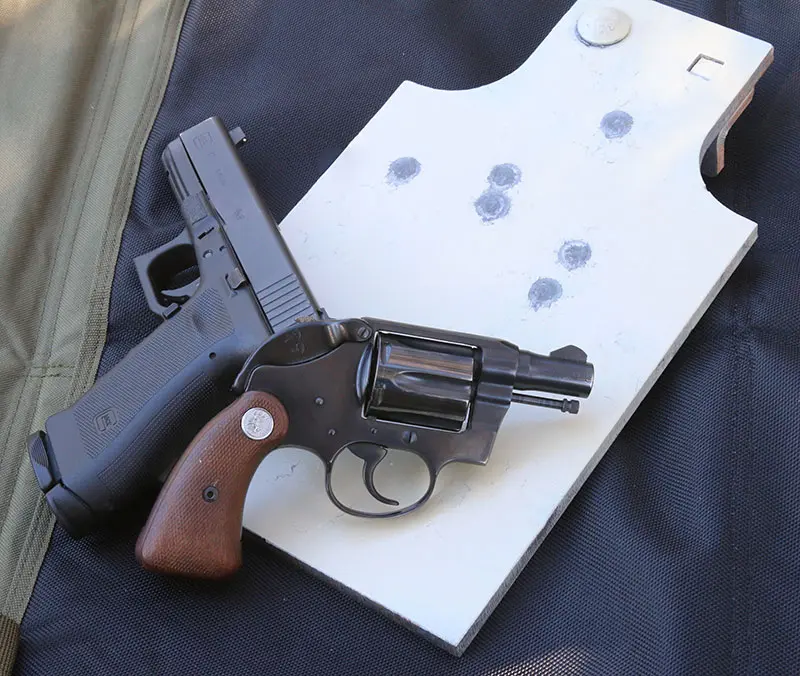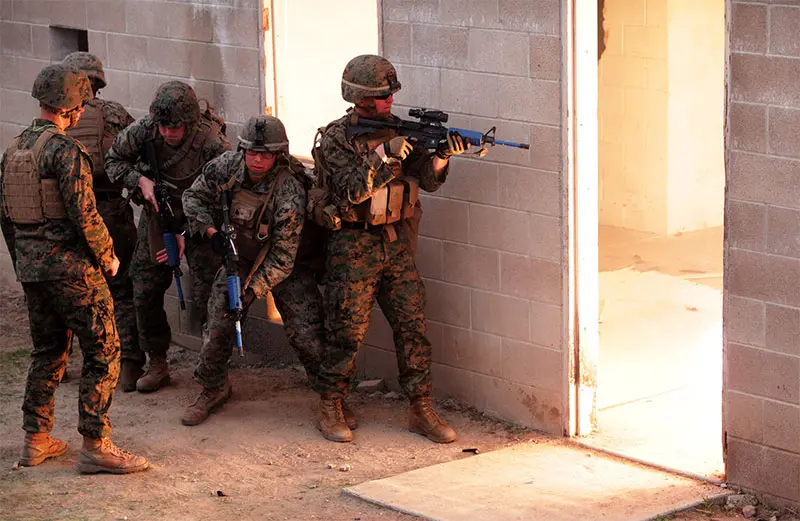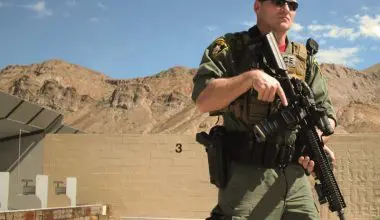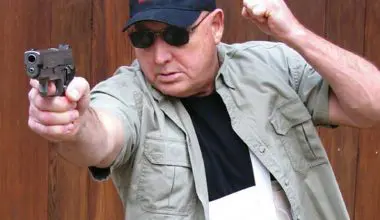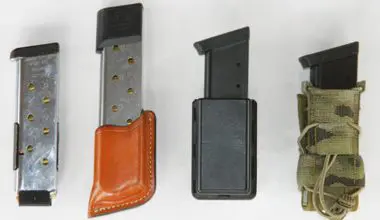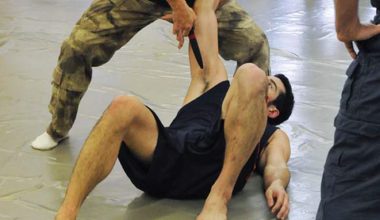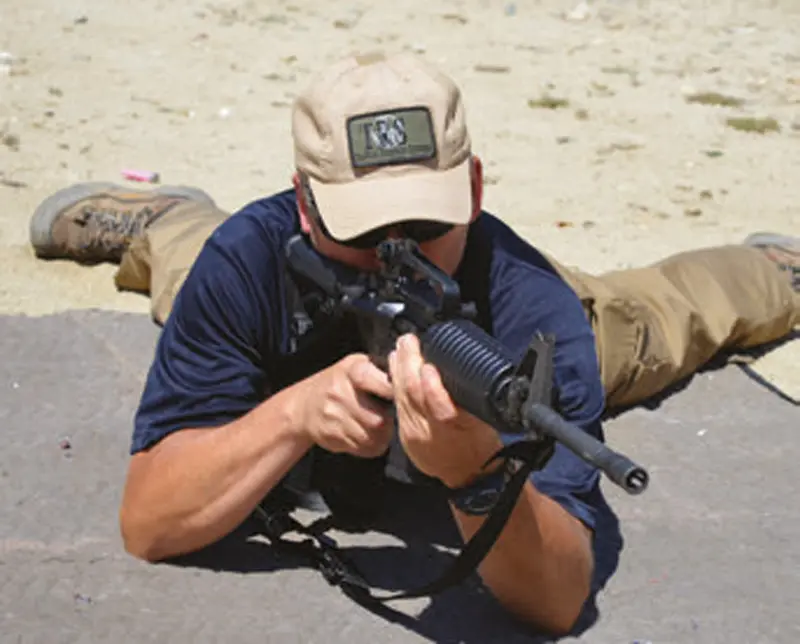
When using a rifle, many different shooting positions are available to enhance your accuracy and tactical advantage.
Different positions tend to be more applicable at certain distances than others. Some positions are used for stability while others are used for mobility. Some of the positions outlined here are well-known classic positions. Others are less known but are invaluable in tactical situations.
The classic positions are prone, supported kneeling, sitting (cross-legged or open-legged), and standing. Tactically related positions are high kneeling (with or without front elbow support), squatting, crouching, rollover prone, supine, and team combinations of prone, kneeling, and standing. The tactical positions tend to be more mobile than the classic shooting positions, but each serves a purpose.
Whatever position you use, you must provide a stable platform while launching projectiles at your target. All positions are trade-offs among speed, tactical appropriateness, and stability. Choose the position that will best fit your particular need.
Table of Contents
SHOOTING FUNDAMENTALS
While shooting from any of these positions, adhere to proper shooting fundamentals, which are:
- Proper shooting position
- Grip: Shooting hand on the pistol grip and support hand on the forend of the rifle.
- Sight alignment: Proper alignment of optic or sights.
- Sight picture: Your target, where you want to hit.
-
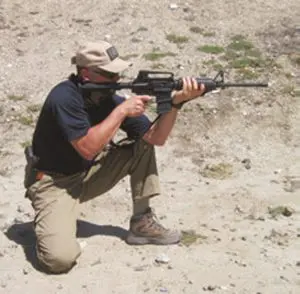
Supported kneeling position can be almost as stable as prone. Breathing: Nice steady breathing with a pause for pulling the trigger. Everyone tries to tell you when to pause, but don’t listen. Do what feels best for you.
- Trigger control: Even and steady pressure to the rear without disrupting sight alignment and sight picture. Do not bounce your finger on and off the trigger. Press and hold the trigger down during recoil, then release it until it resets. There is no reason to take your finger off the trigger until you are done with your engagement.
- Follow through: Your mental check of how you did on the other fundamentals and evaluation of the accuracy and effectiveness of your hit.
I will outline each position and explain when they are useful and tactical. When training, wear appropriate outdoor clothing to protect yourself from the environment. If possible, wear padding on your knees and elbows. I have seen numerous injuries from elbows and knees hitting rocks and other objects. Since this is a physical activity, it’s a good idea to limber up before practicing the positions.
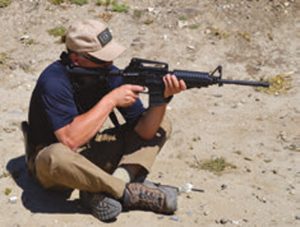
CLASSIC POSITIONS
Prone
A proven position, prone provides a stable platform for accurate long-range target engagement. It can also help you stay behind cover or concealment and decrease your exposed body mass.
In the prone position, try to keep as much of your body in contact with the surface as possible. You are on the ground, so use it for support. Straighten your legs out and flatten your feet on the ground.
Some shooters like to bend one or both knees. This tends to raise at least one hip and your stomach off the ground, and some shooters say it allows them to breathe more easily. It does not matter, as long as you are flat and using the surface to support yourself. The more supported you are, the less fatigued you will become. Do what is most comfortable, as long as it allows you to make accurate hits.
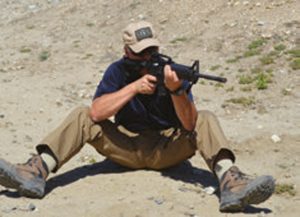
Support your rifle with bone stability instead of muscle strength. Muscles eventually become fatigued and less effective at stabilizing the weapon, unlike bones, which provide a more stable shooting platform with less overall fatiguing.
Remember not to squeeze the weapon too tightly. It is not needed for accuracy and only contributes to fatigue. If possible, shoot with both eyes open. Even closing one eye can cause facial fatigue. At first, it is hard to shoot without closing the non-shooting eye, but with practice it becomes easy and natural.
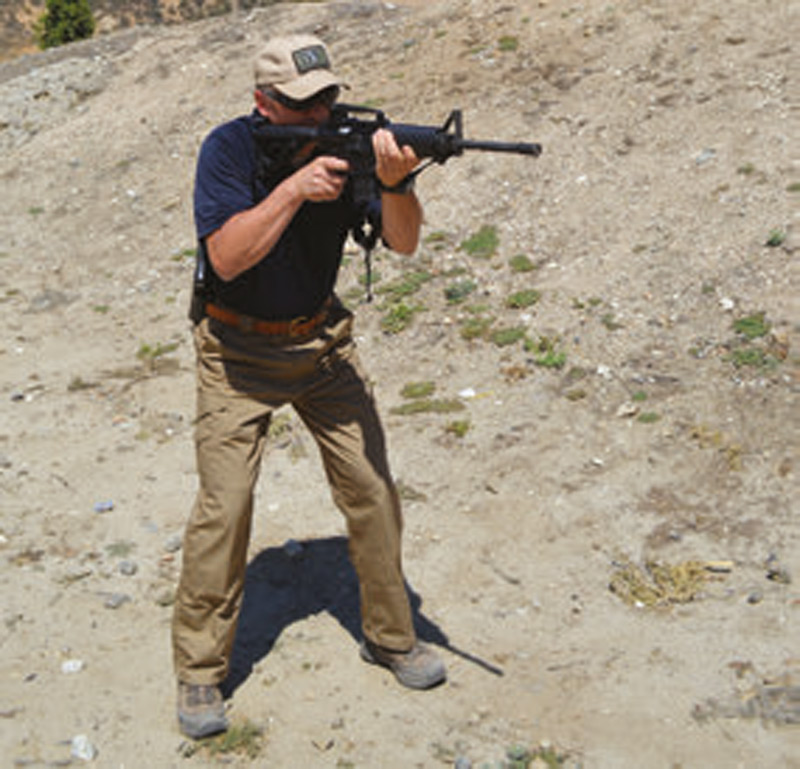
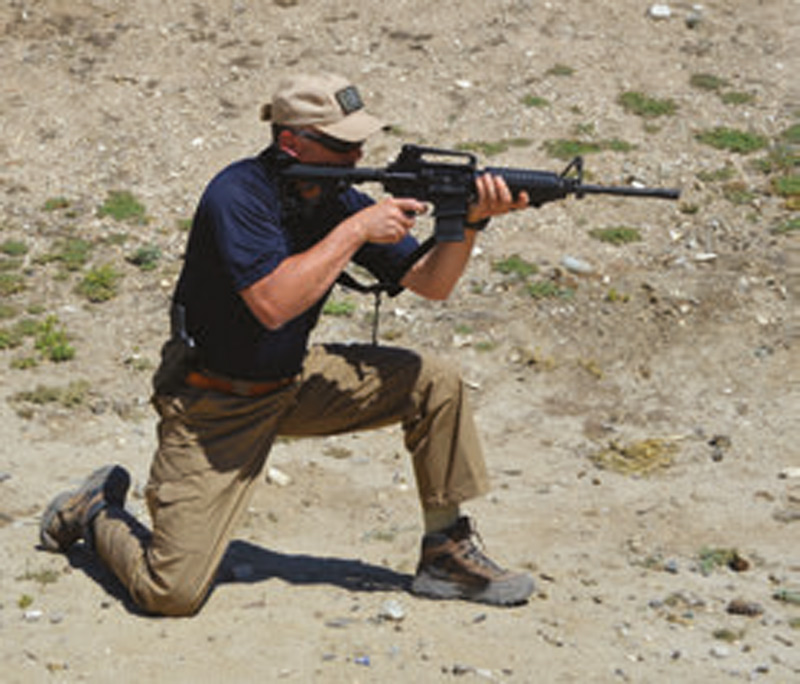
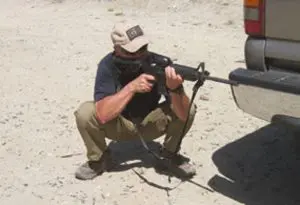
Supported Kneeling
Supported kneeling is another stable position for mid- and long-range shooting. It is a quicker position to get into and out of than prone, and it gives you more clearance from ground obstructions and natural rises between you and the target.
To get into the kneeling position, step back with your shooting-side leg and go down to that knee. Sit back onto your ankle. You have a choice on foot position. In the first method, the foot can be positioned so that the top of the foot is flat against the ground in an extended position.
The second way to do it is to have the foot flexed and toes bent back so that your weight is on top of the ball of your foot. This second method has the top of the foot off the ground instead of flat against it. Either way, sit back onto your ankle for stability.
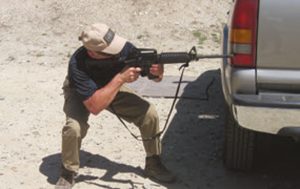
Your non-shooting-side shin should be near vertical. Your ankle should be at a right angle, with the sole of the foot completely on the ground.
Your front leg acts as a platform for your support (nonshooting) arm. Place the outside portion of the support arm on the inside of your front knee. Do not place your elbow joint on the knee, as this creates a wobbly contact point. Use your arm isometrically against your knee, which stabilizes your support arm. Your front arm has support, but your shooting arm does not, so you have to monitor fatigue in this arm.
Although useful, this position can be hard to use if you have ankle, knee or hip issues. Your knees go into very deep bends, which can be uncomfortable and even painful if you have any knee problems. Further, your shooting ankle is under a great deal of stress. It needs to have the flexibility to bend and support your body weight. Your non-shooting hip can experience tightness if it is not flexible enough for the position. You can do flexibility exercises to overcome these problems.
Sitting
Your next positions are sitting either cross- or open-legged. The cross-legged position is a classic shooting position, but open-legged is gaining popularity. Both of these positions offer good stability for mid- to long-range engagements.
The cross-legged position is a little slower to get into but provides a rock-solid platform. Sit down and cross your legs with your knees bent. Place your elbows inside your inner legs and use isometric tension between your arms and legs.
There is a tendency to shoot low in this position. This is because the shooter lowers his head to the rifle and raises the rear of the gun to meet his face. Make sure you acquire proper cheek weld (cheek contact with the rifle stock) and eye alignment with the sights or optic.
The open-legged position is quicker to get into and out of because you don’t spend time crossing your legs. That is, unless you are practiced at getting down and up again with your legs crossed. Not too many people can do that. Further, it gives you more lateral movement options, because it is easier to adjust left and right by moving your feet.
In the open-legged position, the knees are kept bent so that the shooter can support his arms, the same way as when in the crossed position. You can raise and lower your knees to accommodate the height you want the rifle to be. You are still able to use isometric pressure to stabilize your shot. The open-legged position is a little more adaptable than the cross-legged because of the ease with which you can raise and lower your knees. Use your heels against the ground to maintain desired position.
Standing
The standing position is a classic shooting stance, but we modify it into a tactical position. Instead of blading the body and keeping the shooting arm up, we get into a stance that we can more easily move in. We then drop the elbow down to both tighten control on the gun and streamline the body.
In the standing position, stand evenly weighted on both legs, with your feet, knees, hips, and shoulders square to the target. Bend forward slightly at the waist to control recoil and maintain an aggressive fighting attitude. Lock your elbows down to control your weapon.
TACTICAL POSITIONS
High Kneeling
The first tactical position is high kneeling. It is called high because the shooter does not sit back on his ankle. To get into this position, step forward with the non-shooting leg and go down on the shooting knee. Depending on the speed and distance of the shot, the shooter has the choice of supporting his support elbow on the front leg or just shooting without support.
This is a very fast position to get in and out of. It is used to lower the body profile or take advantage of available cover or concealment. It isn’t as stable as the classic kneeling position, but you are giving up stability for speed. This position is good for close- to mediumrange engagements.
Squatting
Squatting is another very fast, mobile position and provides the opportunity to use isometric support in a rapid timeframe.
Squat down until your hamstrings (the back of your upper leg) make contact with your calves (the back of your lower leg). Keep your feet flat, feet and knees slightly wider than your hips, weight centered and balanced over the entire length of the soles of your feet.
Next, place the back of your upper arms inside your knees (similar to the seated positions) and use isometric tension for weapon and recoil management. A great position for close- to medium-range targets, you will be able to get into and out of it quickly. Be careful if you have ankle, knee, hip or back problems.
Crouching
Crouching is a hybrid of standing and squatting. Employ it whenever you need to use cover or concealment or to shoot through an opening that is too low to shoot through when standing but too high when kneeling. You can get into and out of the position quickly and easily, and with conditioning can stay in the position for a short amount of time.
When crouching, keep your feet flat on the ground and body weight centered. You will be able to lean right or left if needed to be able to shoot around cover and concealment.
Rollover Prone
Rollover prone is a great position to use when trying to engage targets under vehicles and other low openings, where the prone position does not work.
In rollover prone, you engage while lying on one side or the other. Spread your legs and support the position on three points—your shoulder, both legs and feet. This will provide a very stable platform to shoot from.
People always worry about the brass not ejecting properly and creating a stoppage with the rifle, but this won’t happen. There is enough space for the case to exit the ejection port. As long as your rifle is in good working order, it will function properly.
If you lie on your non-shooting shoulder, be aware that the empty case will shoot upward, possibly giving your position away. Don’t worry about that. Get good hits and the bad guy won’t have the chance to shoot back.
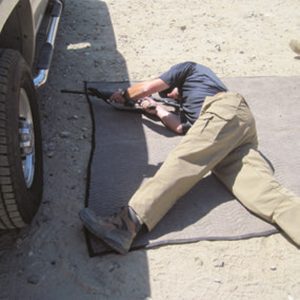
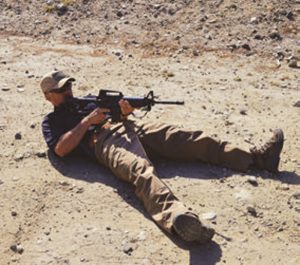
Supine
Supine can be used as an emergency shooting position when you have fallen down, or used tactically to shoot through openings or around cover and concealment that cannot be accessed with other shooting positions.
In this position, you lie on your low back and buttocks and use core strength to stabilize yourself. Keep your arms in tight to manage the weapon. Keep your legs spread for a couple reasons: First, it will help keep your feet out of the way so that you do not shoot them. Second is again to provide stability by giving you three points of contact: your back and/or butt, and two legs and feet.
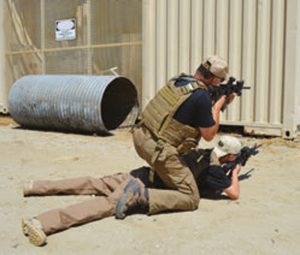
Once you feel comfortable with each basic position, practice efficiently getting in and out of them and moving among different positions to engage various targets. This will help with your overall mobility.
TEAM POSITIONS
Two basic team positions are used in tactical environments. They are generally used to engage threats from behind cover and concealment.
The first is team prone/kneeling. One partner assumes a prone position and the other kneels over the top of him. This means the team has the ability to engage threats with both weapons at the same time, giving them additional fire suppression over the adversary.
If you are on top, do not put your weight onto your partner’s lower back.
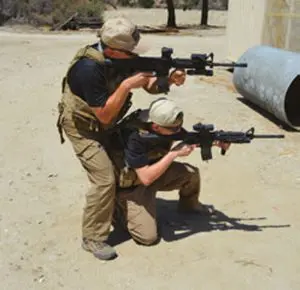
Since you are working as a team, stagger your fire with your partner. Do not get caught with both shooters emptying their magazines at the same time. Make sure one team member loads while the other continues to engage or cover the threat area.
The second team position is team kneeling/standing. One partner kneels down while the other stands over him. Again, both can engage the threat simultaneously.
If you are the standing partner, make sure your muzzle stays ahead of your kneeling partner. Do not allow him to stand up in front of your muzzle. If he tries to stand up before you are ready for him to, push him down and keep him from getting up in front of you.
The standing partner can brace his knees against the lower partner. Use each other for stability but be careful not to step on the kneeling partner’s legs or ankles, which can lead to injury or destabilization.
Using proper shooting positions lets you take advantage of the terrain and available cover and concealment in any tactical situation. Proper understanding and practice will enhance your survivability and allow you to dominate your environment.
